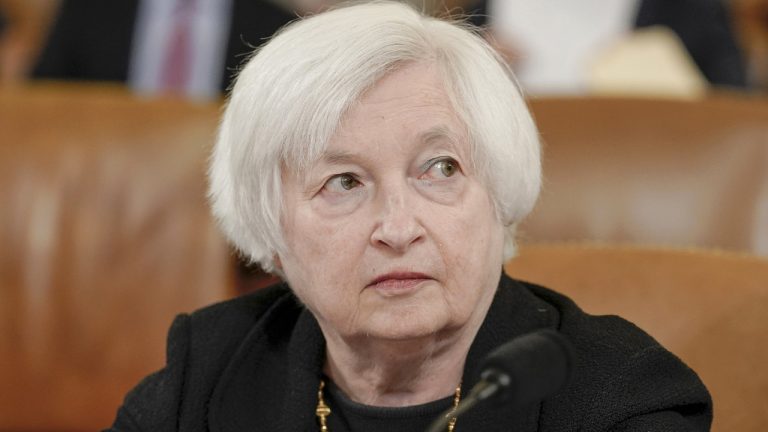
JPMorgan Chase, the largest bank in the US, has acquired the majority of collapsed First Republic Bank after it was seized by the Federal Deposit and Insurance Corporation (FDIC). In a press release, JPM says it has acquired approximately $173 billion worth of loans, $30 billion worth of securities, and $92 billion worth of deposits, […]
The post US Government Sells Nearly $300,000,000,000 in Assets to JPMorgan After Collapse of First Republic Bank appeared first on The Daily Hodl.

Shares of First Republic tumbled 50% in a matter of hours on Tuesday as the troubled bank revealed a massive flight of customer capital. The bank says customers pulled $100 billion worth of deposits out of the bank in March – a number that surprised analysts and fueled fresh concerns about the health of the […]
The post $100,000,000,000 Exits First Republic Bank in 30 Days, Insiders Expect US Government To Seize Troubled Institution appeared first on The Daily Hodl.
 U.S. Treasury secretary Janet Yellen initiated an unscheduled Financial Stability Oversight Council (FSOC) meeting with the country’s top financial regulators on Friday amid issues plaguing the U.S. banking sector. Banking stocks and all four U.S. benchmark indexes fell again on Friday as the government’s efforts last week failed to quell the country’s financial calamity. Janet […]
U.S. Treasury secretary Janet Yellen initiated an unscheduled Financial Stability Oversight Council (FSOC) meeting with the country’s top financial regulators on Friday amid issues plaguing the U.S. banking sector. Banking stocks and all four U.S. benchmark indexes fell again on Friday as the government’s efforts last week failed to quell the country’s financial calamity. Janet […] After UBS acquired Credit Suisse and close to a dozen financial institutions injected $30 billion into First Republic Bank four days ago, S&P Global downgraded First Republic’s shares to junk status on Sunday. Investors are concerned that the cash infusion from 11 major financial institutions may not address the bank’s liquidity issues. First Republic’s shares […]
After UBS acquired Credit Suisse and close to a dozen financial institutions injected $30 billion into First Republic Bank four days ago, S&P Global downgraded First Republic’s shares to junk status on Sunday. Investors are concerned that the cash infusion from 11 major financial institutions may not address the bank’s liquidity issues. First Republic’s shares […]
Silicon Valley Bank and Signature Bank set off a cascade among banks that haven’t been handling their finances responsibly. Let them face the consequences.
When crypto markets took a hit after the collapse of FTX and other crypto lenders last year, some crypto critics repeated the mantra, “Let crypto burn.” Now, it’s big banks that are faltering — including Credit Suisse and First Republic — after regional banks, including Signature Bank and Silicon Valley Bank, sparked a cascade. As a result, Moody’s has downgraded the entire banking sector.
If “Let crypto burn” was a snappy way of saying that operating outside the financial system means more personal responsibility and heightened risk, fine, crypto natives understand that concept. But now, we have a chance to turn a critical lens on the traditional financial system.
With traditional banks experiencing financial pressure, it’s time to let many of them fail. Forest fires can burn away old growth to make way for new trees to sprout. The same principles apply to banking.
Politicians and crypto critics have aligned to build the narrative that crypto is the risk at the heart of the crisis. The dirty little secret is that Treasury bonds were the nuclear bomb at the epicenter of this banking crisis, and central bank interest rate policy was the plane that delivered the payload.
Related: Expect the SEC to use its Kraken playbook against staking protocols
These struggling banks loaded up on long-term treasury bonds during a period of near-zero interest rates and at a time when the United States Federal Reserve continued to try to mollify banks that they would keep rates near zero for the foreseeable future.
There is an unavoidable tradeoff between low-interest rates and inflation; Fed macroeconomists know this, and yet the Fed acted with surprise as it quickly raised rates to catch up to the inflation wildfire over the last two years. A steep rise in rates made the old long-term treasuries — the ones paying very low interest — sharply decrease in value. When depositors demand their money back (with heightened speed in the era of internet banking) and all you have to sell to pay them are junk Treasuries, you have a problem.
The Federal Reserve has given Treasury bond holdings preferential treatment in its regulations and supervisory approaches (including those from which SVB was recently exempted). This puts blame on the Federal Reserve from two directions, its surprise about-face on interest rate policy and its regulatory policy favoring Treasury holdings.
War stories are tedious but I will tell one. When I was senior counsel at House Financial Services in 2014 I subpoenaed the Fed about its management of conflicts of interest over its running a payment system. Turned up crazy stuff…they totally use regulation to help Fedwire. https://t.co/4V3qjUTkub
— J.W. Verret, JD, CPA/CVA (@JWVerret) March 16, 2023
There are many highly inefficient aspects of TradFi, where rotten trees are choking the growth of new sprouts. Some are a result of similar pathologies where the government uses the banking system to subsidize its own political objectives. It would be better for the economy to let them burn.
Much of the business model of taking in fiat short-term, on-demand deposits, and parking that money in illiquid long-term Treasurys (subsidizing the government) or mortgage-backed securities (where the government subsidizes unaffordable home prices) needs to burn away.
Rent-seeking brick-and-mortar facades, with most customer service outsourced overseas and who earn most of their revenue from overdraft fees, need to burn. Payment systems that bribe cardholders with “cash back” programs then use the market power their consumer bribes give them to gouge the merchant, need to burn.
Related: The Federal Reserve’s pursuit of a ‘reverse wealth effect’ is undermining crypto
Some smaller and regional banks who have failed to innovate, and for which the otherwise unobtainable bank charter has become the modern-day taxi medallion ensuring them rents from third-party custody of fiat deposits, need to burn away some of the overgrowth as well.
Crypto is a revolution in finance, intended to replace the intermediary-centric financial system with a self-sovereign approach where the individual is able to digitally custody native financial assets themselves.
This transformation will take time. Developers at decentralized finance (DeFi) protocols and layer-1 blockchains live most of their lives in the fiat economy. The federal government will only accept fiat dollars for tax payments, while banks dominate real estate mortgages.
DeFi protocols are making inroads into home mortgages, but that’s at its earliest stages. Consumer finance and tax payments are still fiat-based. And crypto developers at a minimum deserve the same treatment as anyone else participating in the fiat economy. That means they shouldn’t be discriminated against in the provision of basic checking and savings accounts.
We need some of the banking system to survive. But we don’t need all of it to survive, and the parts that burn away open opportunities for crypto-native replacements if banks don’t unfairly discriminate against crypto clients.
This article is for general information purposes and is not intended to be and should not be taken as legal or investment advice. The views, thoughts and opinions expressed here are the author’s alone and do not necessarily reflect or represent the views and opinions of Cointelegraph.

BTC margin and option markets show no signs of discomfort or overconfidence despite 28% gains in two days.
The price of Bitcoin (BTC) increased by 28% between March 12-14, reaching $26,500, its highest level since June 2022. Some may attribute the gains to the consumer price index's (CPI) 6% year-over-year increase in February, even though the figure was in line with expectations.
The inflation metric reached its lowest level since September 2021, which is a positive development, but it does not validate the Federal Reserve's attempt to reduce the metric to 2%. Most likely, risk markets, such as stocks and cryptocurrencies, soared after regional bank stocks recovered from their March 13 lows.
At 10:30 a.m. Eastern Time, First Republic Bank (FRC) shares were trading 54% higher, followed by Western Alliance Bancorporation (WAL) gaining 46% and KeyCorp (KEY) gaining 15%. The 30-year average mortgage rate decreased to 6.6% from 7.1% on March 7. Consequently, reduced mortgage rates have the potential to improve the housing market, which partially explains the rally.
The unexpected decline in mortgage rates may present an opportunity for price-sensitive homebuyers and homeowners waiting for a chance to lock in a lower rate. According to data from Realtor.com, a buyer of a median-priced home still faced a monthly mortgage payment that was 49% higher than it was one year prior.
Despite the possibility of a recession in the United States due to high interest rates, China's economic outlook remains positive. Li Qiang addressed reporters on March 14 for the first time since assuming the position that oversees the State Council, China's highest executive body. According to Qiang, non-state-owned enterprises in China will have greater room for development.
Let's look at derivatives metrics to better understand how professional traders are positioned in the current market conditions.
Margin markets provide insight into how professional traders are positioned because it allows investors to borrow cryptocurrency to leverage their positions.
For example, one can increase exposure by borrowing stablecoins and buying Bitcoin. On the other hand, borrowers of Bitcoin can only take short bets against the cryptocurrency.

Since March 13, OKX traders' margin lending ratio has been above 35, indicating a significant mismatch in favor of Bitcoin longs. Readings above 40 are uncommon and driven by a high stablecoin borrowing cost of 25% per year.
One should refer to the BTC option markets to confirm whether professional traders are effectively expecting further price increases.
Options traders are far from excited
Traders should also analyze options markets to understand whether the recent correction has caused investors to become less risk-averse. The 25% delta skew is a telling sign whenever arbitrage desks and market makers overcharge for upside or downside protection.
The indicator compares similar call (buy) and put (sell) options and will turn positive when fear is prevalent because the premium for protective put options is higher than the premium for risk call options.
In short, if traders anticipate a Bitcoin price drop, the skew metric will rise above 8%, and generalized excitement has a negative 8% skew.
Related: SVB and Silvergate are out, but major banks are still backing crypto firms

On March 13, when Bitcoin broke above the $22,000 resistance level, the BTC options' main risk gauge exited the fear zone that had been in place for three days. As options traders assigned the same risk assessment to bullish and bearish strategies, the 25% delta skew entered a neutral zone.
However, it would be incorrect to conclude that the negative 5% skew seen briefly on March 14 indicates excessive optimism or bullishness. Analysts and pundits frequently jump the gun and celebrate quick reversions, but anything between -8% and +8% remains in the neutral zone.
According to the pricing of options contracts, derivatives data indicates that professional traders maintained their long positions using margin markets and exited their bearish stance on March 13. Given the improvement in macroeconomic market conditions, Bitcoin bulls are well-positioned to drive the price above $26,000.
The views, thoughts and opinions expressed here are the authors’ alone and do not necessarily reflect or represent the views and opinions of Cointelegraph.